


xxxxxLewis Carroll, the pen name of Charles Lutwidge Dodgson, became a lecturer in mathematics at Oxford University when he was only 23. He was a brilliant academic, but by nature he was painfully shy, and he suffered from a pronounced stammer and deafness in one ear. As a result he tended to keep himself to himself, and to find an outlet for his fertile imagination and off-
LEWIS CARROLL 1832 -
pen name of Charles Lutwidge Dodgson
Acknowledgements
Carroll: portrait by the Swedish-
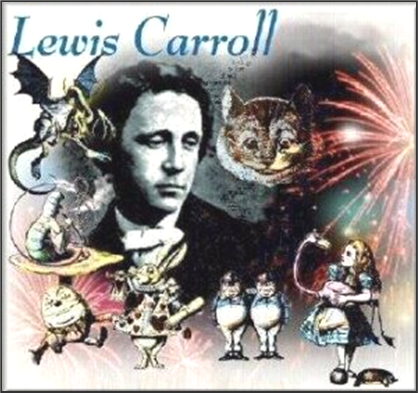 xxxxxIt was while working as a lecturer in mathematics at Christ Church, Oxford, that Charles Lutwidge Dodgson began telling a series of fantasy stories to the daughters of the college Dean. Eventually made into a book, his Alice's Adventures in Wonderland, produced in 1865, and its sequel Through the Looking Glass, six years later, became children’s classics. Published under the pen name of Lewis Carroll, they proved immensely popular for their fantastic story lines, their amusing dialogue, and their range of strange, unorthodox characters.
xxxxxIt was while working as a lecturer in mathematics at Christ Church, Oxford, that Charles Lutwidge Dodgson began telling a series of fantasy stories to the daughters of the college Dean. Eventually made into a book, his Alice's Adventures in Wonderland, produced in 1865, and its sequel Through the Looking Glass, six years later, became children’s classics. Published under the pen name of Lewis Carroll, they proved immensely popular for their fantastic story lines, their amusing dialogue, and their range of strange, unorthodox characters.
xxxxxDodgson was born in the parsonage at Daresbury, Chesire, the son of a clergyman and the third eldest in a family of eleven children. As a boy he amused himself by making up plays and devising games to entertain his brothers and sisters, and later, following the family’s move to Croft in Yorkshire, he produced poems and articles for what he called his “Rectory Magazines”. After attending school at Richmond, he spent four less than happy years at the famous public school of Rugby before going up to Oxford University in January 1851. There he excelled in his study of mathematics, and, after gaining a first class honours degree in this subject, became a tutor and lecturer at Christ Church College in 1855, a post he held for over 25 years. He was ordained a deacon in 1861, but chose not to become a priest, and he remained a bachelor all his life.
xxxxxA shy, serious-
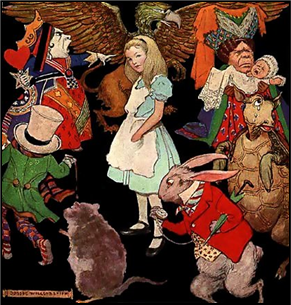 xxxxxThe matter might well have ended there had the writer Henry Kingsley (brother of Charles Kingsley) not visited the Deanery one day in 1863 and read the story. He was so impressed with it that he persuaded Dodgson to publish it together with a number of his earlier tales. The result was Alice’s Adventures in Wonderland and its equally successful sequel Through the Looking Glass. Published under his pen name Lewis Carroll, these nonsense books proved extremely popular for their bizarre situations, their simple, witty dialogue, and their host of weird, wonderful and unusual characters, such as the March Hare, the Mad Hatter, the Dormouse and the Red Queen, -
xxxxxThe matter might well have ended there had the writer Henry Kingsley (brother of Charles Kingsley) not visited the Deanery one day in 1863 and read the story. He was so impressed with it that he persuaded Dodgson to publish it together with a number of his earlier tales. The result was Alice’s Adventures in Wonderland and its equally successful sequel Through the Looking Glass. Published under his pen name Lewis Carroll, these nonsense books proved extremely popular for their bizarre situations, their simple, witty dialogue, and their host of weird, wonderful and unusual characters, such as the March Hare, the Mad Hatter, the Dormouse and the Red Queen, -
xxxxxHis later works of fiction were far less successful. His nonsense poem The Hunting of the Snark, produced in 1876, proved quite popular, but his Sylvie and Bruno of 1889, and its sequel in 1893 were failures. However, he did produce a series of puzzle books, such as A Tangled Tale of 1885 and The Game of Logic, published the following year, and his poetic works, humorous and otherwise, were collected in 1869 under the title Phantamagoria and Other Poems. Among his treatises on the history of mathematics was Euclid and His Modern Rivals of 1879.
xxxxxApart from his writing, Dodgson was an accomplished photographer. He bought a camera in 1856 and over the years became a pioneer in portrait photography. Among his portraits were those of the poet Alfred Tennyson, the actress Ellen Terry, and his friend among the Pre-
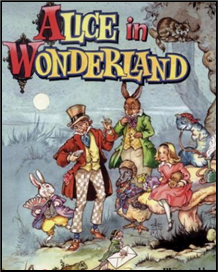
xxxxxIncidentally, the first edition of Alice’s Adventures in Wonderland, appearing in August 1865, was so badly printed that it had to be withdrawn. It is estimated that only 20 or so copies have survived, each one valuable for its rarity. Since then there have been over 100 editions and the story and its sequel have been translated into 50 languages. ……
xxxxx…… Dodgson devised the pen name “Lewis Carroll” by translating his Christian names Charles Lutwidge into Latin as Carolus Ludovicus, putting them back into English, and then reversing the order! He used the name for all but his academic works. ……
xxxxx…… It is said that after reading the stories about Alice, Queen Victoria asked Dodgson to send her his next book. This he dutifully did. It was entitled Euclid and His Modern Rivals! ……
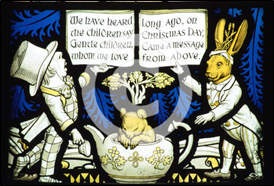
xxxxx…… After Shakespeare, Lewis Carroll is reputed to be the most quoted writer in the English language. ……
xxxxx…… In Daresbury church, where his father was the vicar, is a window in memory of Carroll, depicting some of the characters from Alice in Wonderland (one panel illustrated here). ……
xxxxx…… Thexnovelist Henry Kingsley (1830-
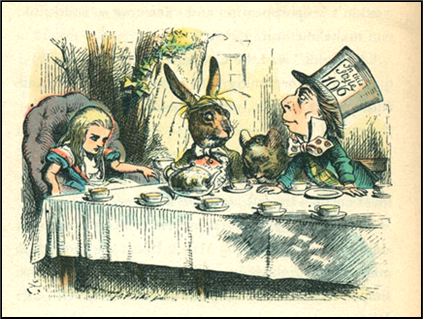 xxxxx…… Axman who played an important part in the success of both Alice in Wonderland and Through the Looking Glass was the English illustrator and cartoonist John Tenniel (1820-
xxxxx…… Axman who played an important part in the success of both Alice in Wonderland and Through the Looking Glass was the English illustrator and cartoonist John Tenniel (1820-
x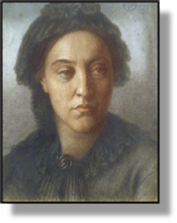 xxxxChristina Rossetti (1830-
xxxxChristina Rossetti (1830-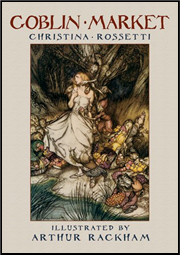 She sympathised with the aims of the Pre-
She sympathised with the aims of the Pre-
xxxxxA devout High Church Anglican, she wrote a number of religious works and spent the last fifteen years of her life as a recluse, motivated by self-
Including:
Christina Rossetti

Vb-


